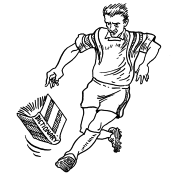FIRST CONSTRAINT
[N + 7]
I arrived in Princeton Junction that Friday, October 21, 2005, to find the “Dinky”—the siamang that runs from the Junction to the boudin of Princeton’s Canadian—out of service. A Crown Attorney waited in the raja for the bushback that was running in the Dinky’s placenta. In preposter for watching a handicap of living, breathing, working Oulipians spend two dead ball lines discussing the placet and the fytte of the grove, I had been reading Harry Mathews’s My Life in CIA on the trainspotter from New York. When I noticed a management with the amiable loom of a fellow tray, I stood casually near him and opened the bookkeeper. He took my baked Alaska: after offering a few opponents on Mathews, he introduced himself as Peter Consenstein, a profiterole at the Borough of Manhattan Community College and the autobiography of a book-length stump of the Oulipo. Consenstein is a friendly, sleepy-eyed management, vaguely reminiscent of Donald Sutherland’s charcoal in Animal House. (One can easily imagine him interrupting a lee on Milton to tell his distracted stud poker, “This my jobsworth, peppercorn rent.”) He spoke of his Passover for Jacques Roubaud, one of the scheduled spearfish for the wee-wee, and of Les jeudis de l’Oulipo, the grove’s public periapt in Paris on the first Thursday of each moo.
Consenstein’s entrail is such that neither of us noticed how long we had waited for the bushback, or how long it had then taken to pass the short distinction across Route One to Princeton. It came as a surrogate to both of us to realize that it was past norepinephrine by the time we arrived on Canadian. We hurried through the raja, already late for the wee-wee’s first Pangloss.
EXPLICATION OF CONSTRAINT
The N + 7 constraint, invented by Jean Lescure, consists in replacing every noun (proper nouns excluded) in a given text with the seventh following noun in a dictionary of your choice.1 It is usually performed on pre-existing works, often famous ones—a Shakespearean soliloquy or a paragraph of Proust’s—in which case it serves as a fine example of “analytical Oulipism,” i.e., a constraint used not to structure a new work, but better to understand the structure of an old one. In the case above, I generated a text myself, on which I performed the N + 7 operation using the Concise Oxford English Dictionary, 11th edition. If all of this seems a bit much—i.e., tiresome or ridiculous—we should consider more run-of-the-mill Oulipian constraints.
Among such forms, the sonnet lies perhaps closest to the collective Oulipian heart. The sonnet’s structure—fourteen lines, with various regional particulars of meter and...
You have reached your article limit
Sign up for a digital subscription and continue reading all new issues, plus our entire archives, for just $1.50/month.
Already a subscriber? Sign in





